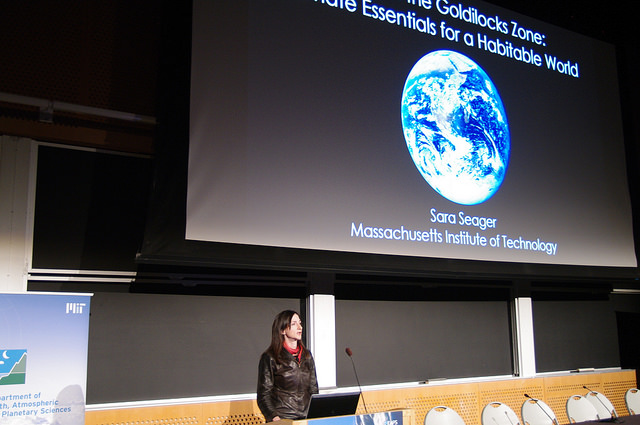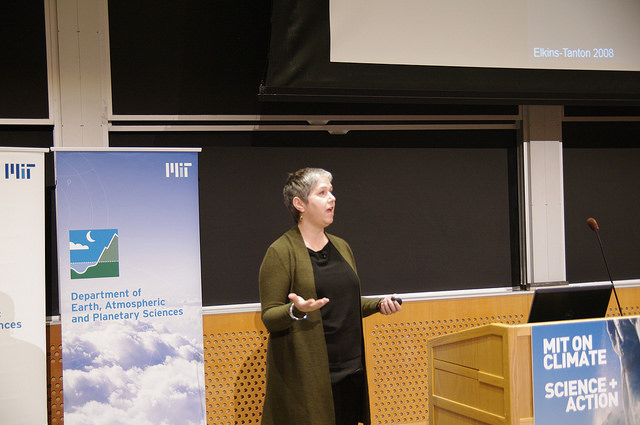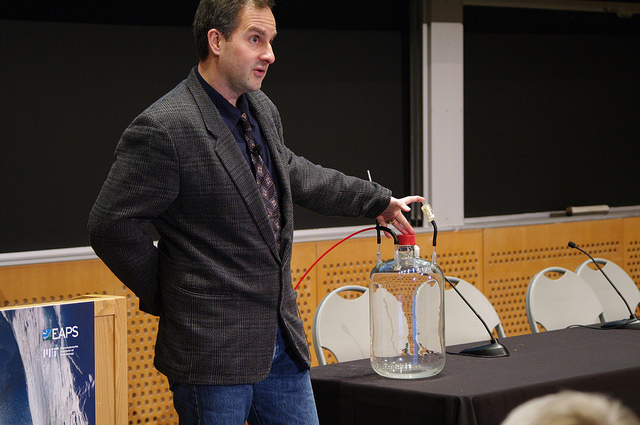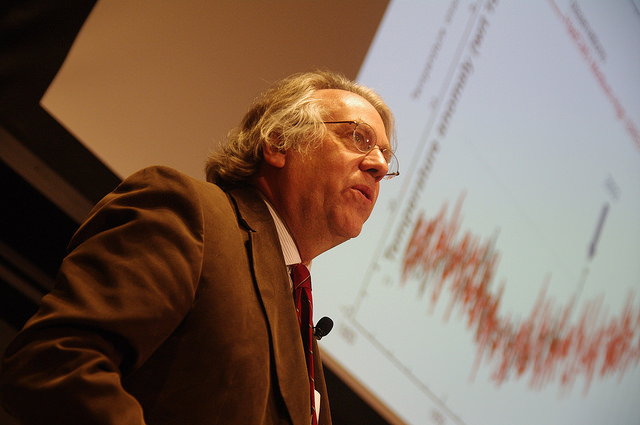PAOC Spotlights
Research Takes Center Stage at MIT Climate Conference
At MIT on Climate=Science + Action, speakers examined what we know, what’s left to learn, and the diverse climate-related research happening throughout the institute.
***
Days after news broke that NASA and NOAA declared 2015 the hottest year on record—a second record-breaking year in a row—leading MIT researchers gathered for MIT on Climate=Science + Action, a daylong symposium aimed at defining the key role of basic science in understanding and reacting to climate change. Speakers examined what we know, what’s left to learn, and the diverse climate-related research happening throughout the institute—from exoplanets to the deep ocean and everything in between.
“Effectively addressing climate change is a defining challenge of our time,” said Raffaele Ferrari, the Breene M. Kerr Professor of Oceanography and organizer of the event. “We are losing sight of the nature of climate science, and our fledgling understanding of the climate system. We are not putting enough resources to theory and observations. It is crucial that we continue basic research if we want a positive outcome for humanity and the environment.”
Past and Future Climate Clues
The first speaker of the day was astrophysicist Sara Seager, who is best known for searching outer space for earth-like exoplanets. Although researchers have yet to discover earth-like planets, they already know of many that are earth-size. Seager uses computer models of exoplanet atmospheres and telescope data to analyze their climate dynamics and potential habitability. “In studying other earths and searching for them, we remind ourselves of fundamentals,” Seager said. “We hope that by finding other planets, we can learn something that might be helpful for us in the future.”

When we think about climate, we often think of it in relation to Earth. But there are just as many climates as there are planets, and those climates also evolve over time. The idea of other life-sustaining planets is a tantalizing possibility, and some people have even suggested moving to such planets in the face of hypothetical climate disasters. “I can assure you, that although there are so many planets out there, space is vast and habitable planets are too far away to get to,” she said. “Earth is a very special place, and we must take care of it.”
While Seager searches the far reaches of the universe for climate clues, MIT Assistant Professor David McGee searches Earth’s natural archives—stalagmites, lake deposits, marine sediments, and other geologic records documenting our planet’s climate history. “Looking at paleoclimate allows us to ask what the role of climate was in evolution, the rise of complex life and humans, and mass extinctions,” he said. It also allows us to place the changes we are currently experiencing in a broader context.
Earth’s history provides a rich array of natural experiments that offer unique insights into the workings of the climate system. McGee’s research focuses on understanding the atmosphere’s response to past climate changes and how Earth transitioned from periods of almost complete ice cover to periods of extreme warmth. He uses a combination of geochemical measurements, uranium-series dating, and model simulations to reconstruct past changes in precipitation and winds as well as offer data-based insights into the patterns, pace, and magnitude of these changes.
McGee and others have found surprising variations in temperature, precipitation, ice volume, and carbon dioxide levels throughout Earth’s history. Based on the observed and modeled data, carbon dioxide appears to be a primary driver of past climate changes. McGee is working to better understand these variations and their contribution to the climate system. “[The paleoclimate] contains surprises. There are times we see changes we don’t expect. It’s a fantastic learning opportunity and a place of discovery.”
One thing researchers have discovered through the paleo-record is how drastic changes in climate have shaped life on Earth. Lindy Elkins-Tanton, a former MIT professor now the director of the School of Earth and Space Exploration at Arizona State University, discussed her research that provides strong evidence for a possible cause of the most catastrophic event in Earth’s history—the end-Permian extinction.

About 250 million years ago, something caused the extinction of 90 percent of ocean species and 70 percent of terrestrial species. Around this time, a series of giant volcanic eruptions occurred in what is now Siberia, Russia, which expelled magma over more than 800,000 square miles that flowed for millions of years. Some scientists blame these eruptions for climatic changes that contributed to the extinction, but the connection is hard to prove.
By analyzing basaltic rocks—remnants of the eruptions—and using climate modeling, Elkins-Tanton and colleagues found evidence that sulfur, chlorine, fluorine, and carbon were released during the eruptions. These gasses radically altered atmospheric chemistry, ocean chemistry, and climate, which likely had enormous repercussions for all multicellular life. Further geologic evidence suggests sulfur generated acid rain, and the chlorine, fluorine, and carbon combined to destroy parts of the ozone layer. “This is mother nature burning hydrocarbons to change the climate, only 252 million years ago,” she said. “I would posit this catastrophe is similar to the kind of catastrophe we are creating today, but what we are doing is much more rapid. The lesson is that Earth is going to be fine, but we’ve got some work to do to maintain our quality of life.”
The Nuts and Bolts of Climate Science
The next set of speakers have dedicated their careers to understanding our present climate and how it’s shaped by various factors—including human activity. Dan Cziczo, MIT Associate Professor of Atmospheric Chemistry, investigates how anthropogenic emissions impact climate dynamics. “This is really the area of uncertainty in our current understanding of climate,” he said.
Humans not only pollute the atmosphere with greenhouse gasses that trap heat and warm the planet, we also emit microscopic man-made particles. Scientists know that atmospheric particles counteract warming to some degree by reflecting sunlight into space and acting as seeds on which clouds form. But the impact of industrial aerosols—dust containing remnants of heavy metals such as zinc, tin, and lead—remains uncertain. “We are putting particles into the atmosphere,” Cziczo said. What affect do they have on clouds, their currents, frequency, location and ability to reflect radiation back into space?”

Cziczo’s group use a combination of laboratory and field studies to understand how particulate matter interacts with water vapor to form droplets and ice crystals, which are important components of the climate system. Laboratory experiments include using small chambers to mimic atmospheric conditions that lead to cloud formation—which Cziczo enthusiastically demonstrated for the audience. In the field, he flies into clouds to collect samples using specialized tools. Back in the lab, Cziczo can analyze the particles to understand their sources and test them to see if and how they alter cloud formation. “This is something that is extremely difficult to model,” he said. “It’s something we have to understand to get our projections right in the future.”
Following Cziczco’s talk was MIT Oceanographer John Marshall, who discussed the role of oceans in climate. Seventy percent of Earth’s surface is covered by the ocean, and it acts as major controller of climate through exchanging heat and carbon with the atmosphere, absorbing heat into its interior, transferring energy around the globe, and forming ice to reflect radiation back into space. One way Marshall studies the fundamental role oceans play in climate is through modeling “aquaplanets”—models of Earth-sizes planets covered entirely in water designed to simulate circulations among the atmosphere, ocean, and sea ice.
By manipulating certain variables, Marshall can identify how the relationship between the atmosphere, ocean, and sea ice contribute to the creation of ice-covered poles and inter-glacial climate periods like we have now, as well as periods of glacial maximums and snowball Earths. “Studying the climate of these aquaplanets is fun,” Marshall said. “It informs us about the elemental role of the ocean in climate. We can ask what the essential things are about [various climate conditions].”
Some of the most important factors driving climate are ocean and atmospheric asymmetries, Marshall said. As the ocean carries heat from the Southern Hemisphere to the Northern Hemisphere, the atmosphere compensates for this imbalance by transferring energy from North to South. Using these models, Marshall can closely examine how these asymmetries interact. But aquaplanets aren’t just useful for studying Earth’s climate. MIT astrophysicist Sara Seager and Marshall have worked together and continue to work together using these models to think about the climate dynamics of exoplanets.
The ocean is certainly important to the climate system, but so are land masses. “My role is to convince you that land does matter,” said Elfatih Eltahir, professor of civil and environmental engineering in the MIT Parson’s Lab, eliciting laughter from the audience. “Land surface processes do matter in shaping climate variability at regional scales,” he said. “When it comes to actionable science, we have to focus on climate processes that are relevant to society, which happen at regional and local scales.”

Eltahir’s research uses model simulations to examine how soil moisture, vegetation, heat fluxes, solar radiation, and rainfall interact in various regions of the globe to impact climate and people’s lives. He gave three examples of recent studies that show how climate variability creates “winners and losers.” The Persian Gulf is known as the hottest spot on Earth, and it’s poised to get a lot hotter in the future according to model simulations. So hot, in fact, that the region may become uninhabitable. While extreme warming in Asia may lead to the displacement of millions of people, warming in Africa could lead to a decrease of infectious disease in the region, Eltahir said. Projected changes in hydrology and climate forcings may kill more mosquitos, lessening the risk for Malaria expansion. Finally, he discussed the impacts of climate change on agriculture in the American Midwest. Although model simulations suggest Illinois should expect intense periods of drought in the coming years, researchers have found no observed trend in the hydrologic cycle over the last 25 years to suggest severe drought is imminent.
“[This last example] highlights the significant uncertainties that come when we talk about regional impacts important to society,” he said. “We need models that are tailored to do processes at regional scales at very high resolutions. We’ve made progress, but there are many challenges in representing these processes. The tools [we have] are still imperfect and they need a lot of work.”
Climate Risks
Researchers are aware that our current climate is changing fast, and could have potentially extreme negative impacts on our way of life. Ronald Prinn, the TEPCO Professor of Atmospheric Science in EAPS and director of MIT’s Center for Global Change Science, emphasized the need for major policy decisions in the face of remaining uncertainties. Prinn used a pair of “roulette wheels,” derived from global climate and economic models, to demonstrate the likelihood of temperature rise under current policies versus proposed strict emissions controls. From MIT News:
Without such action, he showed, there is about a 25 percent chance that the average global temperature increase by the end of this century will be more than 6 degrees Celsius — an amount that would be catastrophic for many regions of the world. And, there is an 80 percent chance of exceeding a 2-degree increase, which is the amount the world’s leaders have agreed is an upper limit on what can be accepted without major disruptions to global economies and populations. Those increases are calculated relative to 1990 levels, the baseline used in the recent Paris agreements, but a more relevant measure, he said, was the increase from pre-industrial levels. By that measure, “business as usual” leads to a staggering 97 percent chance of exceeding a 2-degree increase.
However, if strict emissions standards are implemented over the coming years, we could decrease the chances of exceeding the two degree warming threshold dramatically. “That’s the future we would rather live in,” he said.
Following Prinn’s presentation on how we estimate the costs of curtailing greenhouse gas emissions, MIT atmospheric scientist Kerry Emanuel discussed the costs to humanity if emissions continue at their current rate.

Globally, we are already experiencing rising sea levels, increasing occurrences of severe droughts, floods, high category hurricanes and associated storm surges, heat stress and associated health risks—though regions are affected differently, as Eltahir pointed out. Model simulations indicate these costs are only going to get worse in the future if we don’t take quick, appropriate action. There’s also an economic incentive to mitigate climate change. For example, Emanuel estimates the U.S. could be paying 60 billion dollars annually in hurricane damages by the end of the century if we continue on the current path.
But it’s not all doom and gloom, he noted. “We have gotten better not only in our knowledge of the climate system, but in exploring the frontiers of our ignorance; that is, being able to quantify to the extent we don’t know something. That’s terribly important in assessing risk.”
Some things researchers are still uncertain about are the risks for climate-associated global armed conflict and massive disease outbreaks. “Climate change has historically been an instigator of armed conflicts. Personally it’s the one that frightens me most,” Emanuel said. “It’s also the one that gets the least attention. We have to be cognizant of these risks, because they may turn out to be the more important ones.”
Applying Science to Action
The afternoon session focused on what actions society can take to combat climate-change risks outlined by Prinn, Emanuel, and the other researchers. Speakers discussed evolving energy technologies and their associated economic and health benefits; socio-political obstacles to taking action; processes for negotiating agreements on mitigation measures; and mobilizing the general public through the internet to find viable solutions that fit communities’ needs. Read more in-depth coverage of the afternoon session at MIT News.
Overall, the message throughout the day’s discussions was clear: a strong foundation in basic scientific research is necessary for effective action on climate change. MIT on Climate=Science + Actionwas presented by the Department of Earth, Atmospheric and Planetary Sciences (EAPS) and co-sponsored by the Lorenz Center and the Houghton Fund. Watch the entire symposium again here!